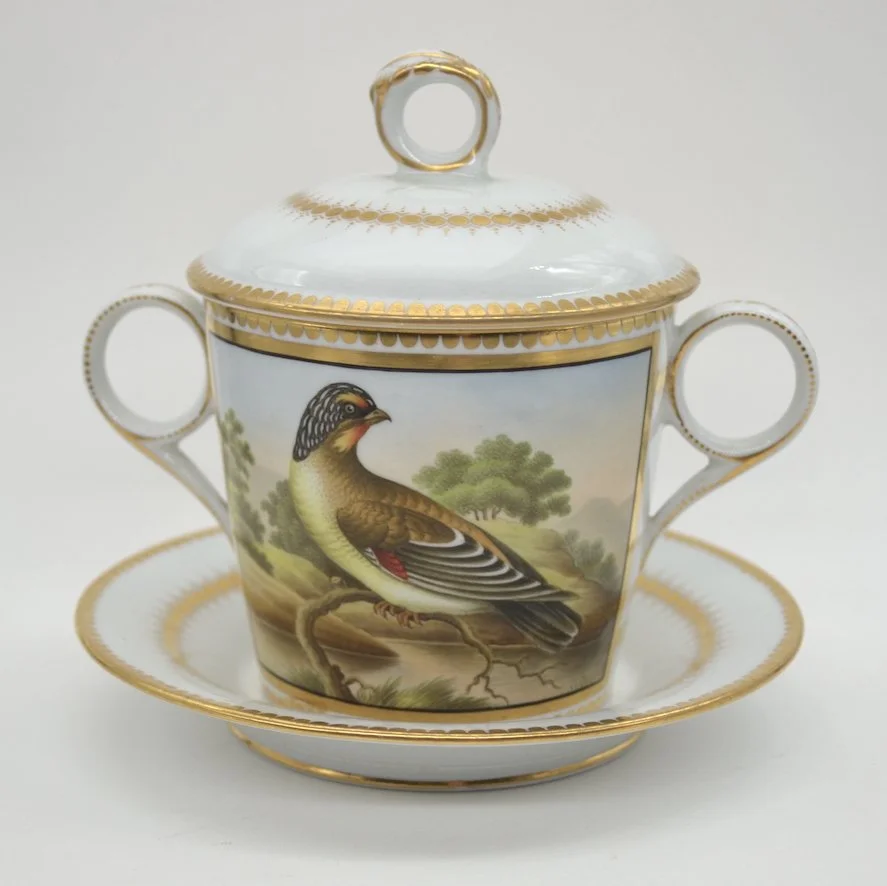[CHAMBERLAIN WORCESTER] [SHAW & NODDER]. Georgian chocolate cup, complete with stand and lid, hand-painted with an Australian ‘Striped Headed Manakin’ after Shaw & Nodder.
[CHAMBERLAIN WORCESTER] [SHAW & NODDER]. Georgian chocolate cup, complete with stand and lid, hand-painted with an Australian ‘Striped Headed Manakin’ after Shaw & Nodder.
Produced: Worcester, Chamberlain manufactory, c. 1810—1815.
Description: slightly tapered cylindrical cup with twin ring-handles, complete with loop-finial lid and matching saucer, standing approx. 12 cm. tall, large hand-painted panel, gilt, each piece with maker’s mark.
Condition: superb original condition.
An Australian pardalote, likely from Cook’s third voyage
An exquisite bespoke depiction of an Australian ‘Striped headed Manakin’ (now Pardalotus striatus) hand-painted on a piece of Chamberlain Worcester for an unknown client around 1810. Such wares, made to order for individual clients, are extremely uncommon, and are almost never seen with any Australian subject.
The beautiful little bird was particularly attractive to European collectors, having first been described and figured by Latham in 1783 in the second volume of his General Synopsis of Birds (1783) with a fine plate (no. LIV) based on a bird “in the possession of Sir Joseph Banks.” Latham was later able to identify it as an Australian species in his first Supplement (1787), where he noted that he had made the identification from the papers of William Anderson (1750—1778), the surgeon who sailed on Cook’s third voyage; meaning that the type locality was in fact Tasmania, where Anderson had called.
As then occurred with scores of Latham’s original descriptions, Gmelin used Latham’s published account as the basis for what would be the first scientific description (1789, but not figured there).
The bird was figured a second time in an early issue of Shaw and Nodder’s influential journal, the Naturalist’s Miscellany (plate dated 1 May 1794). The accompanying text implies that Shaw and Nodder were copying Latham’s record, as seems to be confirmed by the fact that while watercolours of other Australian Pardalotes are in the known corpus of early colonial natural history: this striped species is not apparently recorded in the works of the First Fleet artists, for example.
The one small mystery is that Nodder’s plate – and therefore the unknown bird painter working for Chamberlain’s as well – has improved the colouring from Latham’s original, especially around the eye. Perhaps there were new specimens they had access to (certainly Nodder was in the thick of this ongoing work).
This pretty cup was made by the firm of Robert Chamberlain (c.1736—1798), who had trained under John Wall before starting his own firm in the 1780s. The firm had an enviable reputation for finely painted porcelain, famously making an extravagant service for Nelson and Lady Hamilton, as well as being frequented by the Prince Regent (Museum of Royal Worcester).
The fact that the present cup exhibits almost no wear must suggest that it is in fact what is known as a Cabinet Cup: “very ornately decorated cups… intended purely for ornamental purposes, rather than for drinking from. Some of these cabinet cups were very expensive single pieces priced in keeping with complete tea services of quite fancy and complicated painting… Most examples were equipped with saucers or stands, and some also had covers” (Godden, Chamberlain-Worcester Porcelain, p. 225). Some of the more intricate examples recorded by Godden were sold for 3 guineas or more per piece, an enormous price for the era.
Such is the quality of Chamberlain’s porcelain that the firm’s wares are well-represented in international collections, but precisely similar designs featuring, for example, strictly contemporary natural history illustrations, are rare, the more so with any Australian reference at a time when pheasants, partridges or the occasional phoenix were more the rage (the famous Princess Charlotte service of 1816—1817, for example).
Godden’s extensive catalogue of Chamberlain includes nothing precisely like the present cup – indeed nothing with any identifiably Australian content – but he does reproduce plates which show either a markedly similar style of bird painting (notably fig. 147), a very similar style of other natural history painting, such as shells (plate XVII; fig. 368) or feathers (figs. 382; 383), or a similar dotted-gilt patterned border (figs. 265; 387).
Such wares are all broadly dated around 1810—1815 or a little later, as is confirmed by the simple maker’s mark present here.
References: Binns, Catalogue of a collection of Worcester porcelain in the museum at the Royal Porcelain Works (1882); Godden, Chamberlain-Worcester Porcelain, 1788—1852 (1982); Hobson, Worcester Porcelain (1910); Latham, General Synopsis of Birds, vol. II (1783) and Supplement (1787); Museum of Royal Worcester (online); Shaw & Nodder, Naturalist’s Miscellany, vol. V (1794).

